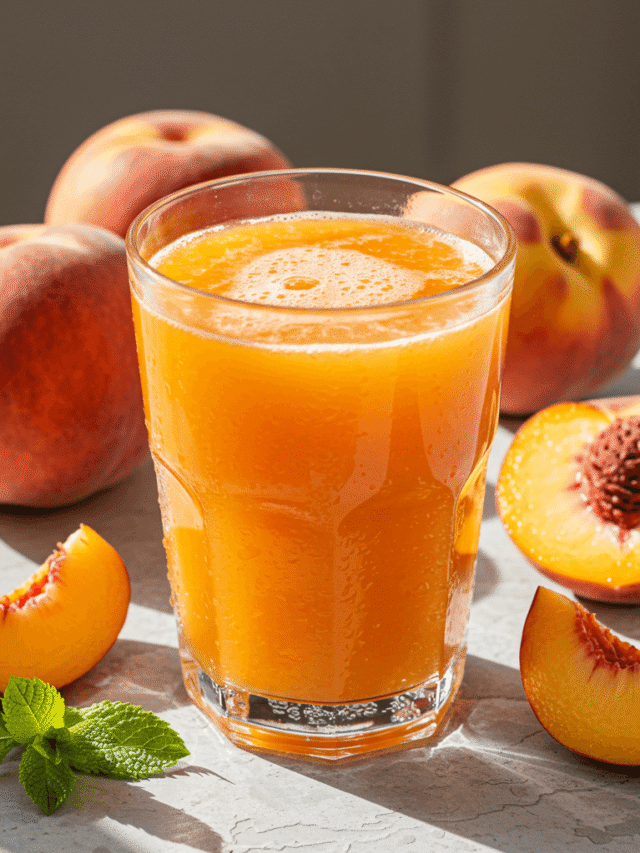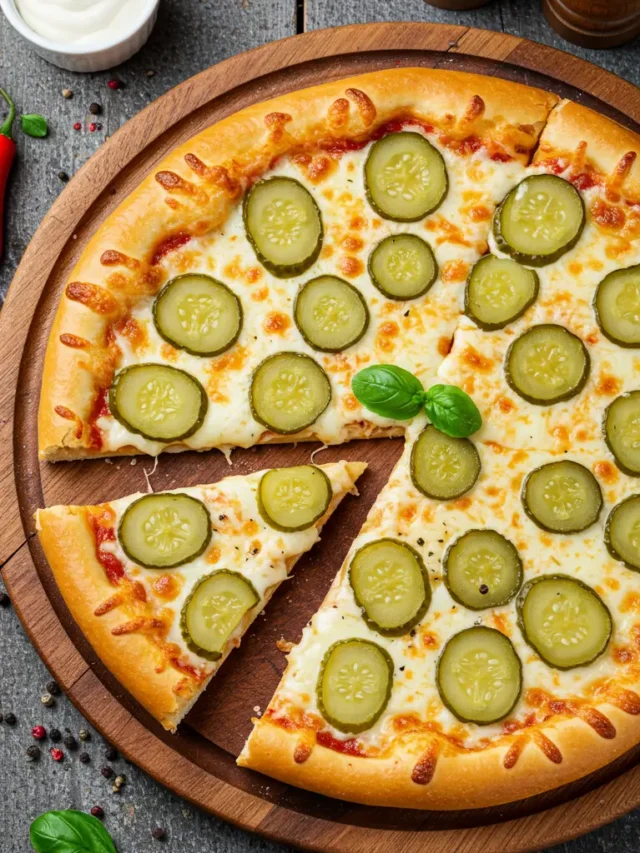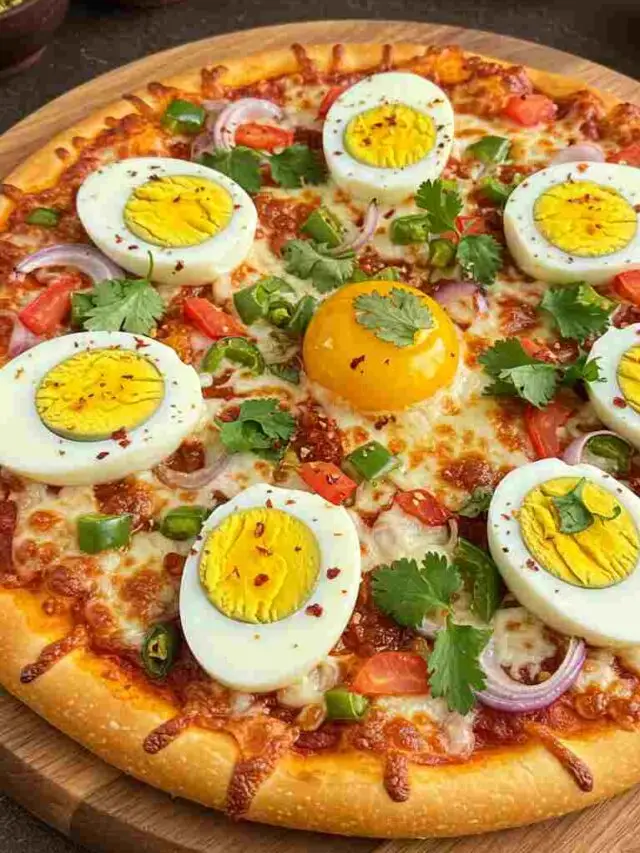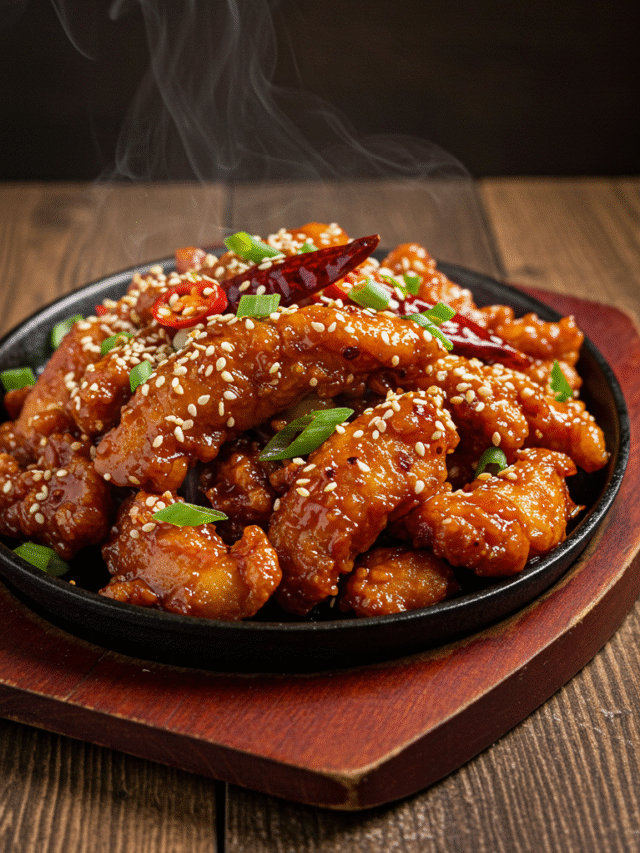Hawaiian BBQ Chicken Recipe combines sweet, tangy flavors with smoky grilling techniques. This dish brings island-inspired tastes to your dinner table with minimal effort. In this guide, you’ll find everything needed to make an authentic Hawaiian BBQ chicken recipe at home.
The roots of Hawaiian BBQ chicken recipe traditions blend traditional Polynesian cooking with Asian influences, creating a unique flavor profile that stands apart from mainland barbecue styles. According to the cultural evolution of Hawaiian barbecue, this fusion began when immigrant workers from Japan, China, and Korea brought their cooking styles to Hawaiian sugar plantations. Their techniques mixed with native Hawaiian methods to create what we now know as Hawaiian-style BBQ chicken recipes.
When making a Hawaiian BBQ chicken recipe, food safety remains a top priority. Safe chicken preparation practices recommend thorough handwashing and avoiding cross-contamination with raw chicken. These simple steps prevent foodborne illness while you create your delicious meal. You might also want to check our Chicken Food Safety Guide for more detailed information.
What is Hawaiian BBQ Chicken Recipe?
The Hawaiian BBQ chicken recipe is known for its harmonious balance of savory and sweet, often featuring ingredients like soy sauce, pineapple, and brown sugar. These create a marinade that infuses chicken with irresistible island flavors.
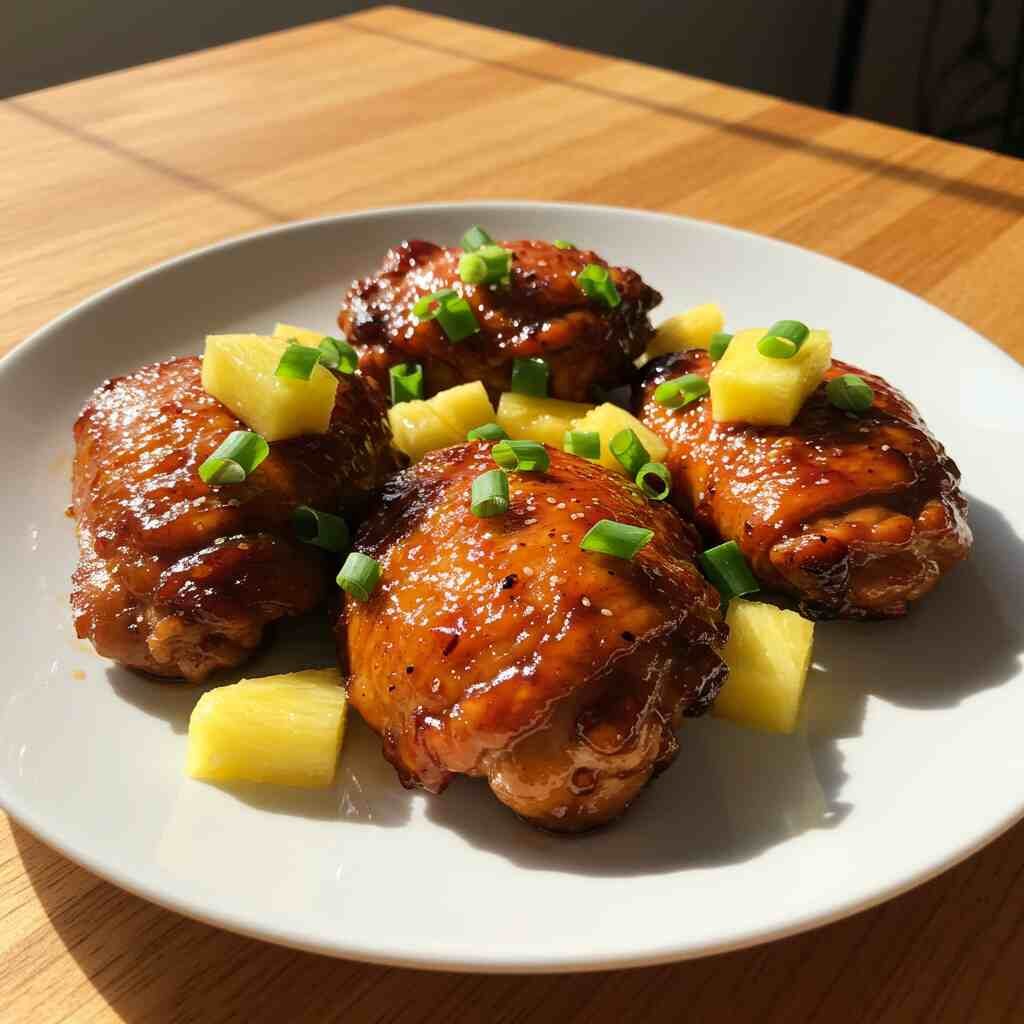
The Origins of Hawaiian BBQ
Hawaiian BBQ chicken recipe history stretches back generations, with roots in:
- Native Polynesian cooking techniques
- Japanese teriyaki influences
- Korean barbecue methods
- Chinese five-spice seasonings
- Portuguese grilling traditions
These diverse cooking styles came together on the islands, creating a barbecue style that highlights:
- Sweet and savory flavor combinations
- Fruity elements (especially pineapple)
- Ginger and garlic aromatics
- Soy sauce base
The modern Hawaiian plate lunch concept took shape in the 1950s as food trucks served workers quick meals featuring grilled meats with rice and macaroni salad. These humble beginnings launched what became a worldwide food trend. For more about Hawaiian cooking history, visit our Hawaiian Cuisine Evolution page.
Hawaiian BBQ vs. Traditional BBQ
The Hawaiian BBQ chicken recipe differs from mainland styles in several key ways:
- Sauce base: Hawaiian sauces use soy sauce, while American BBQ often starts with tomato or vinegar
- Sweetness source: Pineapple and brown sugar in Hawaiian, versus molasses or sugar in mainland styles
- Cooking method: Quick grilling for Hawaiian, slow smoking for traditional American
- Meat preparation: Thinner cuts for Hawaiian, larger cuts for American BBQ
The island-style barbecue also incorporates more tropical fruit flavors and Asian seasonings like ginger and sesame. This creates a lighter, more aromatic profile compared to the heavier, smokier mainland BBQ styles. Our BBQ Styles Comparison offers more insights on different barbecue approaches.
The Perfect Hawaiian BBQ Chicken Recipe
Essential Ingredients
Quality ingredients make all the difference in a great Hawaiian BBQ chicken recipe. Here’s what you’ll need:
- Chicken: Thighs work best (bone-in or boneless)
- Pineapple: Fresh yields better flavor than canned
- Soy sauce: Creates the umami base (low-sodium works fine)
- Brown sugar: For caramelization and sweetness
- Ginger: Freshly grated provides bright, zingy notes
- Garlic: Minced fresh cloves add aromatic depth
- Green onions: Both as marinade ingredient and garnish
- Sesame oil: Adds nutty undertones (a little goes far)
- Rice vinegar: Brings acidity and balance
Hawaiian BBQ Sauce from Scratch
Making homemade sauce for your Hawaiian BBQ chicken recipe brings authentic island flavors to your kitchen. This sauce combines sweet, savory, and tangy elements that make Hawaiian chicken so addictive.
Start with these basic ingredients:
- 1 cup pineapple juice (fresh works best)
- ½ cup soy sauce
- ½ cup brown sugar
- ¼ cup ketchup
- 2 tablespoons rice vinegar
- 2 tablespoons fresh ginger, grated
- 3 garlic cloves, minced
- 1 tablespoon sesame oil
- 2 teaspoons black pepper
The cooking process takes just 15 minutes. Mix all ingredients in a saucepan, bring to a gentle boil, then reduce heat and simmer until the sauce thickens. You’ll know it’s ready when it coats the back of a spoon — the perfect glaze for your Hawaiian BBQ chicken recipe.
This sweet-savory sauce stays fresh in the refrigerator for up to two weeks in an airtight container. For meal prep ideas, make a double batch and freeze portions for later use. Check our Homemade Sauce Storage Tips for more preservation methods.
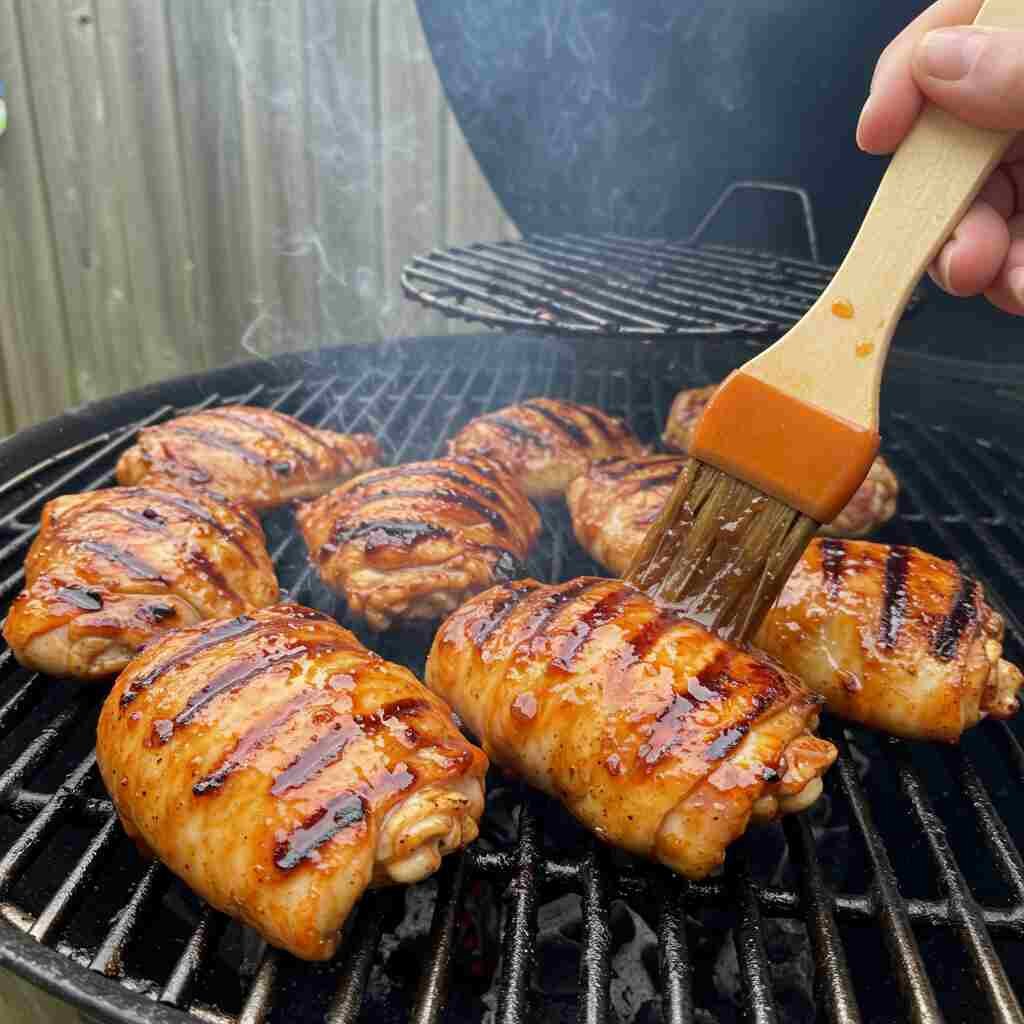
Marination Techniques
Proper marination transforms a good Hawaiian BBQ chicken recipe into a great one. Follow these tips for the best results:
- Use the right container: Choose glass or food-grade plastic containers, never aluminum
- Meat preparation: Score chicken pieces lightly to help sauce penetrate
- Minimum time: Allow at least 4 hours for flavors to develop
- Ideal duration: 8–12 hours or overnight creates the best flavor
- Turning method: Flip chicken halfway through marination
- Temperature safety: Always marinate in the refrigerator, never at room temperature
Pineapple juice in the marinade does more than add flavor. It contains bromelain, an enzyme that breaks down protein fibers in meat. This natural tenderizer makes chicken juicy, but don’t overdo it. Marinating in pineapple juice for more than 24 hours can make the meat mushy.
For an authentic Hawaiian BBQ chicken recipe, place the chicken in a resealable plastic bag with the marinade and press out excess air before sealing. This method ensures the chicken is fully coated. Some home cooks prefer using a traditional Hawaiian marinade technique that includes grated onion for additional tenderizing properties.
Cooking Methods
Grilling Hawaiian BBQ Chicken
The grill method creates the classic char and smoky notes that define a great Hawaiian BBQ chicken recipe. Follow these steps for perfect results:
- Preheat grill to medium-high heat (375–400°F)
- Remove chicken from marinade (save extra for basting)
- Oil grill grates to prevent sticking
- Place chicken on the hot grill
- Cook 6–7 minutes per side for boneless thighs, 8–10 minutes for bone-in
- Baste with reserved marinade during the first half of cooking only
- Check internal temperature reaches 165°F
Grilling techniques vary between gas and charcoal. Charcoal adds extra smokiness that complements the sweet sauce. For gas grills, add soaked wood chips in a smoker box for similar results.
The key to juicy grilled chicken in any Hawaiian BBQ chicken recipe lies in not overcooking. Use a meat thermometer to check doneness rather than cutting into the meat, which lets precious juices escape.
Oven-Baked Hawaiian BBQ Chicken
You can make a delicious Hawaiian BBQ chicken recipe in your oven when grilling isn’t an option. This method works year-round and creates juicy, flavorful results that still capture the essence of island-style barbecue.
Follow these steps for the perfect oven-baked Hawaiian BBQ chicken recipe:
- Preheat your oven to 425°F
- Line a baking sheet with foil and spray with cooking oil
- Arrange marinated chicken pieces with space between each piece
- Bake for 20 minutes
- Brush with additional sauce
- Bake another 5–10 minutes until internal temperature reaches 165°F
- Optional: Broil for 2–3 minutes to caramelize the sauce
The oven method creates tender chicken with a slightly different texture than grilled. The key difference in this Hawaiian BBQ chicken recipe comes from how heat circulates around the meat. Ovens provide consistent, all-around heat that cooks evenly but without the smoky char of a grill.
For extra flavor in your Hawaiian BBQ chicken recipe, add a few pineapple slices around the chicken during the final 10 minutes of cooking. The fruit will caramelize and provide sweet spots to enjoy with your meal.
Many home cooks prefer this method for its convenience and consistent results. The cleanup proves easier too, especially if you line your baking sheet properly.
Slow Cooker and Instant Pot Methods
Modern cooking appliances offer convenient alternatives for making a flavorful Hawaiian BBQ chicken recipe with minimal effort.
Slow Cooker Method:
- Place chicken pieces in slow cooker
- Pour marinade over chicken
- Cook on low for 6–7 hours or high for 3–4 hours
- For a thicker sauce, transfer liquid to saucepan and simmer until reduced
- Optional: Place chicken under broiler for 3–5 minutes to add caramelization
Instant Pot Method:
- Set Instant Pot to Sauté mode
- Brown chicken pieces for 2–3 minutes per side
- Add marinade to the pot
- Seal and cook on Manual/Pressure Cook for 10 minutes (12 for bone-in)
- Natural pressure release for 5 minutes, then quick release
- For crispy skin, broil chicken for 3–5 minutes after pressure cooking
These methods provide versatile ways to prepare a Hawaiian BBQ chicken recipe. The slow cooker creates extremely tender, fall-off-the-bone texture. The meat absorbs more flavor but lacks the caramelized exterior that makes grilled chicken special.
The Instant Pot technique strikes a middle ground—faster than slow cooking but with similar tenderness. The pressure cooking process locks in moisture while infusing flavors deeply into the meat.
Both methods are ideal for busy weeknights when you can’t actively monitor your cooking. They also fill your home with the amazing tropical aromas that define any good Hawaiian BBQ chicken recipe.
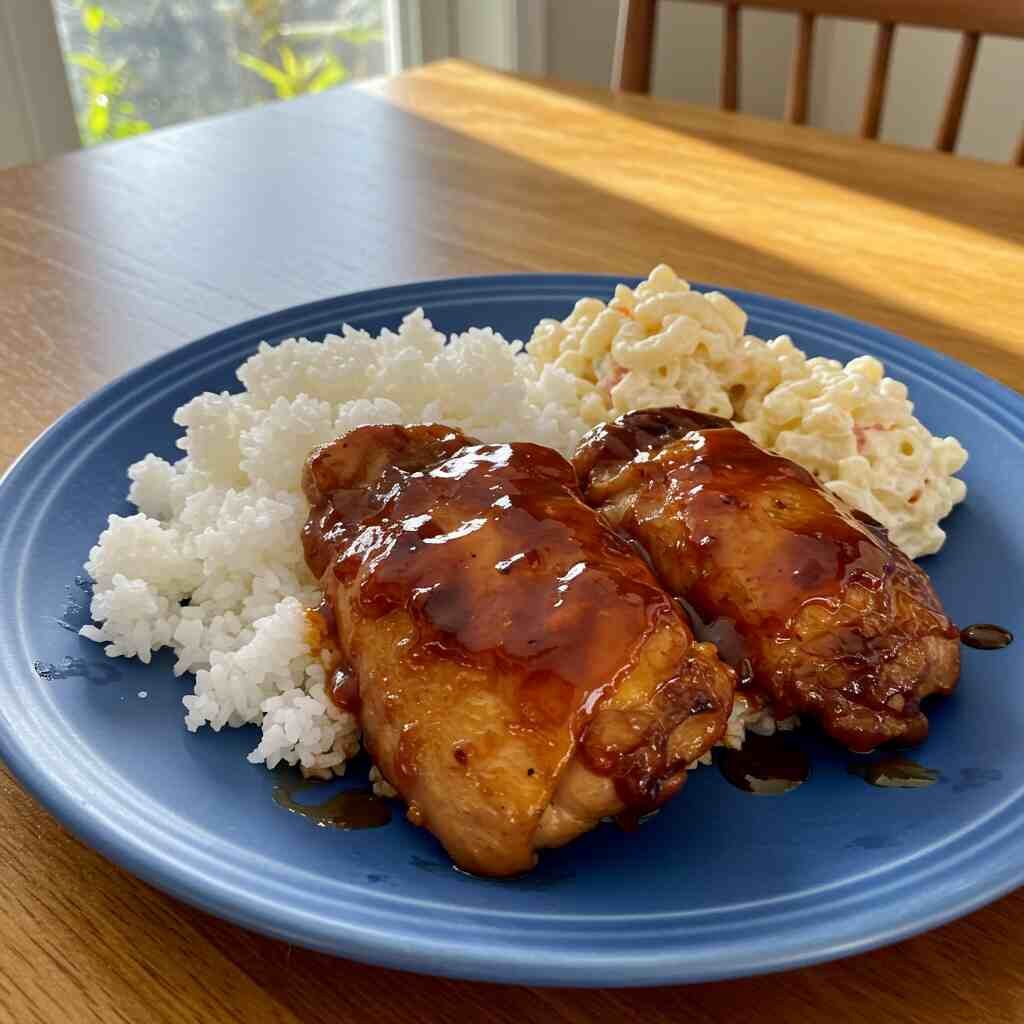
Serving and Accompaniments
Traditional Side Dishes
Authentic Hawaiian BBQ chicken recipes pair with specific side dishes that complete the island experience:
- Macaroni Salad: Made with elbow pasta, mayo, grated carrots, and a touch of sugar
- Steamed White Rice: Simple, sticky short-grain rice
- Grilled Pineapple: Caramelized slices that highlight the tropical flavors
- Hawaiian Coleslaw: Lighter than mainland versions, often with pineapple tidbits
The classic Hawaiian plate lunch typically includes two scoops of white rice, one scoop of macaroni salad, and your protein. This combination balances the sweet-savory chicken with creamy and starchy sides.
For a full island-style meal, add sliced fresh fruits like papaya or mango on the side. The refreshing sweetness cuts through the rich BBQ flavors and cleanses the palate between bites, enhancing the overall appeal of your Hawaiian BBQ chicken recipe.
Modern Fusion Serving Ideas
A Hawaiian BBQ chicken recipe works beautifully in creative, modern dishes beyond the traditional plate lunch. These fusion options bring island flavors to everyday meals with exciting twists.
Try these tasty Hawaiian chicken variations:
- Hawaiian BBQ Chicken Tacos: Fill soft corn tortillas with chopped BBQ chicken, pineapple salsa, and shredded cabbage
- Hawaiian Chicken Bowls: Layer rice, BBQ chicken, avocado, edamame, and pickled vegetables
- Hawaiian Sliders: Mini sweet rolls with BBQ chicken, grilled pineapple, and a slice of provolone
- Hawaiian Chicken Flatbread: Top naan bread with BBQ sauce, chicken, red onions, and cheese
- BBQ Chicken Salad: Mix greens, chicken, mandarin oranges, macadamia nuts, and sesame dressing
No matter how you serve it, a well-prepared Hawaiian BBQ chicken recipe offers versatility and unforgettable flavor. The tropical BBQ taste blends well with many cuisines. Mexican-Hawaiian fusion creates bright, fresh tacos with unique combinations, while the sweet-savory sauce pairs perfectly with creamy avocado and crunchy vegetables.
For quick weeknight dinners, prepare a big batch of chicken using your favorite Hawaiian BBQ chicken recipe on Sunday. Store it in the refrigerator and use it throughout the week in these different applications. This approach saves time while keeping meals interesting.
Kids especially love the Hawaiian chicken sliders—the small size fits little hands, and the sweet-savory flavor profile appeals to young taste buds. Add a slice of pineapple inside each slider for extra tropical taste.
Huli Huli Chicken Variation
What is Huli Huli Chicken?
Huli Huli chicken represents a specific style of Hawaiian BBQ chicken recipe with its own unique characteristics. The name comes from the Hawaiian word “huli,” which means “turn.”
The origin story of this dish starts in 1955 when Ernest Morgado created it for a farmers’ meeting. His marinade combined:
- Hawaiian brown sugar
- Soy sauce
- Ginger
- Garlic
- Chicken stock
- Ketchup
- Sherry
The traditional cooking method involves:
- Butterflying whole chickens
- Placing them on wire racks
- Grilling over kiawe wood (similar to mesquite)
- Turning the chickens repeatedly (hence “huli huli”)
- Basting continuously with marinade
This constant turning and basting creates a deeply flavored, caramelized exterior with juicy meat inside. The signature taste comes from the smoke of the kiawe wood combining with the sweet-savory glaze—an unforgettable version of a Hawaiian BBQ chicken recipe.
Today, Huli Huli chicken is often sold at roadside stands throughout Hawaii, frequently as fundraisers for local organizations. The smell of this cooking chicken draws crowds from miles away, with smoke signals announcing the delicious food ahead.
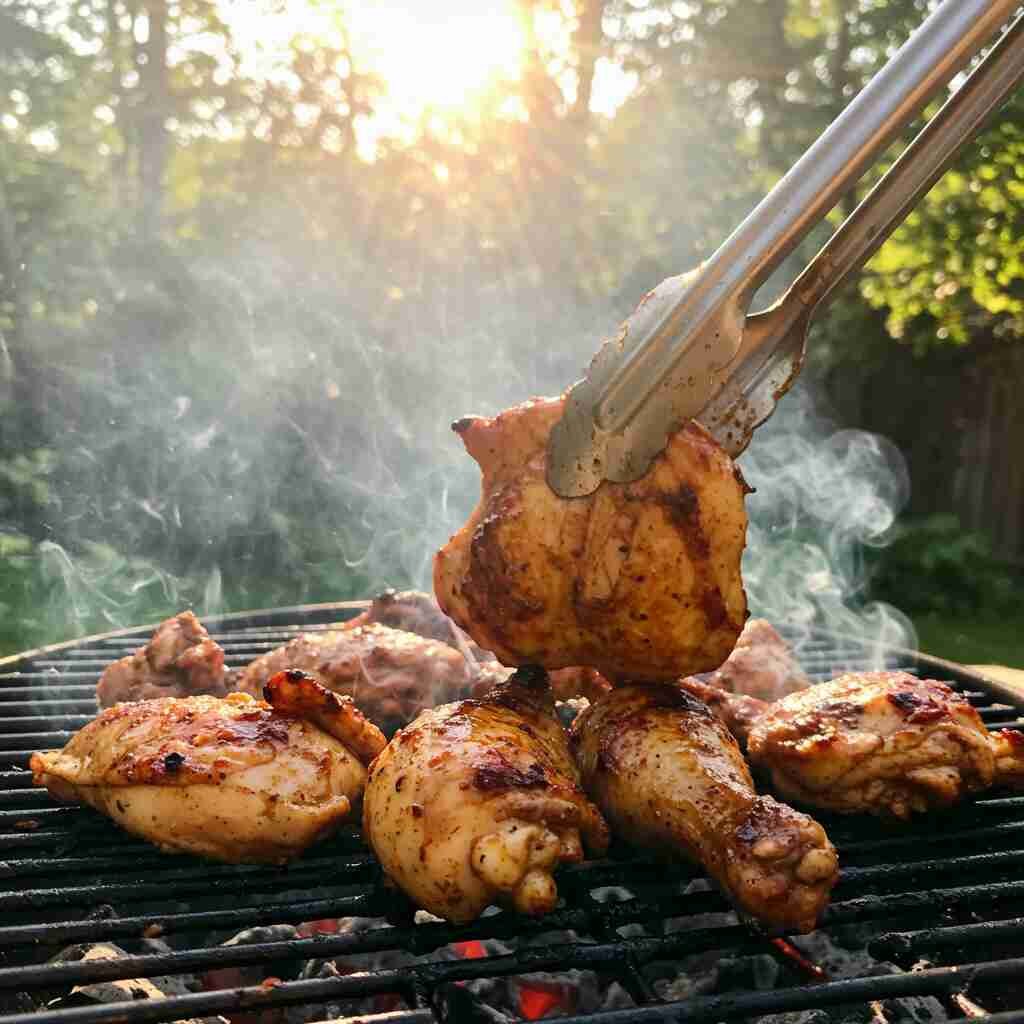
Huli Huli vs. Teriyaki
People often confuse Huli Huli chicken with teriyaki chicken, but key differences separate these two popular Asian-Pacific dishes.
Here’s how they differ:
- Origin: Huli Huli comes from Hawaii; teriyaki originates from Japan
- Sauce Base: Huli Huli uses chicken stock with soy sauce; teriyaki uses primarily soy sauce
- Sweetener: Huli Huli uses more brown sugar; teriyaki uses mirin (sweet rice wine)
- Unique Ingredients: Huli Huli contains ketchup; teriyaki includes sake
- Cooking Method: Huli Huli requires constant turning; teriyaki typically cooks on one side longer
The flavor profile of Huli Huli tends to be more complex with subtle smoky notes and a slightly tangy finish. Teriyaki offers a glossier appearance with a more straightforward sweet-salty balance.
Both styles use ginger and garlic as aromatics, but Huli Huli typically includes more ginger, giving it a brighter, more zingy taste. The texture differences also stand out – Huli Huli chicken has more caramelization from the constant turning and basting.
Most mainland Americans know teriyaki better, as Japanese restaurants spread this style widely across the United States. Authentic Huli Huli chicken remains more regional to Hawaii, though its popularity grows as Hawaiian cuisine gains attention.
Authentic Huli Huli Recipe
The classic Huli Huli preparation starts with the right cut of chicken. Traditionally, cooks use whole chickens split in half, but modern home versions often use chicken thighs for more consistent cooking.
For true Hawaiian Huli Huli chicken:
- Main Ingredients:
- 3 pounds chicken thighs
- 1 cup pineapple juice
- ½ cup soy sauce
- ½ cup brown sugar
- ⅓ cup ketchup
- ¼ cup chicken broth
- ¼ cup rice vinegar
- 3 tablespoons fresh ginger, grated
- 4 garlic cloves, minced
- 1 tablespoon sesame oil
The traditional technique requires:
- Mixing all marinade ingredients thoroughly
- Marinating chicken for at least 8 hours
- Grilling over medium-high heat
- Turning every 5 minutes (the “huli huli” part)
- Basting with fresh marinade (not the used marinade) with each turn
- Cooking until internal temperature reaches 165°F
The constant turning creates even caramelization and prevents burning, while multiple bastings build up layers of flavor. This method takes more attention than standard grilling but rewards you with authentic taste.
Serve this island specialty with sticky rice and macaroni salad for the full Hawaiian experience. The combination of smoky, sweet, tangy chicken with creamy macaroni salad and neutral rice creates the perfect flavor balance.
Troubleshooting and Tips
Common Mistakes to Avoid
Even experienced cooks make errors when preparing Hawaiian BBQ chicken for the first time. Watch out for these common pitfalls:
- Too Much Sugar: Excess sugar burns quickly on the grill
- High Heat Cooking: Hawaiian BBQ needs medium heat to prevent burning
- Insufficient Marination: Skimping on marination time limits flavor development
- Constant Basting: Only baste during the first half of cooking to prevent contamination
- Cutting Too Soon: Not letting meat rest loses precious juices
The biggest problem new cooks face involves the sugar content in the sauce. The brown sugar and pineapple juice create a delicious caramelization, but they also burn easily. Cook over medium heat rather than high, and watch carefully.
Another common Hawaiian BBQ mistake involves the marinade. Never reuse marinade that has touched raw chicken without boiling it first for at least one minute. This kills harmful bacteria. Better yet, reserve some marinade before adding chicken, and use this clean portion for basting.
Many cooks also struggle with chicken doneness. Undercooked chicken poses health risks, while overcooked becomes dry. The perfect internal temperature reaches exactly 165°F – no lower for safety, no higher for juiciness.
Make-Ahead and Storage Tips
A Hawaiian BBQ chicken recipe works wonderfully as a meal prep option. You can prepare elements ahead of time to simplify cooking and extend enjoyment of this tasty dish.
Follow these storage guidelines for best results:
- Marinade: Keeps in refrigerator up to 1 week in airtight container
- Marinated Raw Chicken: Stays good 2 days in refrigerator, 3 months in freezer
- Cooked Chicken: Remains fresh 3–4 days refrigerated, 2–3 months frozen
- Sauce Only: Lasts 2 weeks refrigerated in a jar with a tight lid
For meal prepping, try these approaches using your favorite Hawaiian BBQ chicken recipe:
- Make a large batch of sauce on Sunday and use it throughout the week
- Prepare multiple marinade bags and freeze them with raw chicken
- Cook double portions and repurpose leftovers in different meals
- Portion cooked chicken with rice and veggies in containers for grab-and-go lunches
Freezer storage works well for both raw marinated chicken and cooked portions. For raw chicken, freeze it right in the marinade bag—the meat absorbs flavor while thawing, which is a great time-saving trick.
When reheating chicken made from a Hawaiian BBQ chicken recipe, add a tablespoon of water or pineapple juice before microwaving to maintain moisture. Cover the dish with a damp paper towel for better results. Alternatively, reheat in a 300°F oven for 10–15 minutes for superior texture.
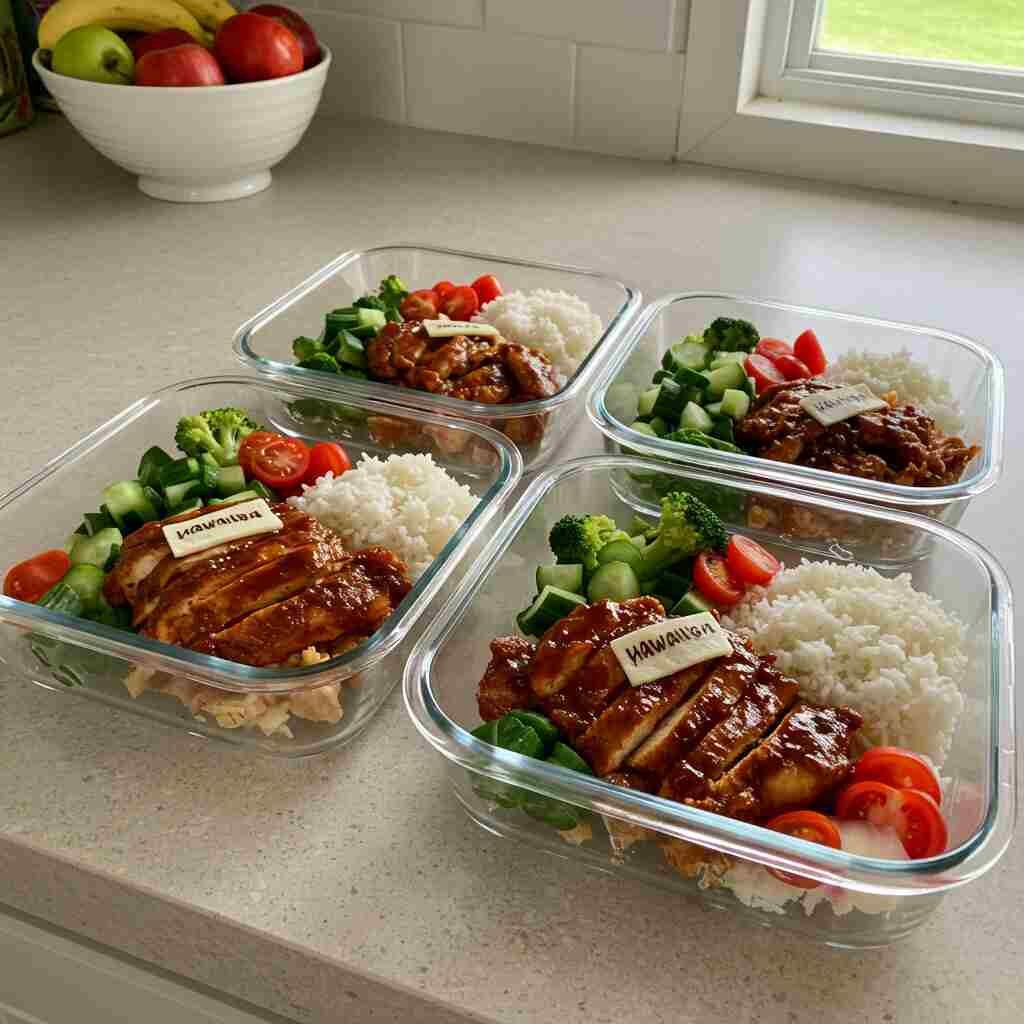
Health and Dietary Adaptations
Nutritional Information
Understanding the nutrition facts helps you fit a Hawaiian BBQ chicken recipe into a balanced diet. A typical serving contains:
- Calories: 350–400 per serving (1 chicken thigh with sauce)
- Protein: 28–32g
- Carbohydrates: 24–28g
- Sugar: 20–22g
- Fat: 14–18g
- Sodium: 800–1000mg
The sugar content comes primarily from brown sugar and pineapple juice. These ingredients contribute to the signature sweet-savory flavor of a Hawaiian BBQ chicken recipe, though they also add to the carbohydrate count. Most fat comes from the chicken thighs, with a small contribution from the sesame oil in the sauce.
The high protein content makes this dish satisfying and supports muscle maintenance. However, due to the soy sauce base, sodium levels run on the higher side—something to consider if you’re watching your salt intake.
When served as a full Hawaiian plate lunch with two scoops of rice and macaroni salad, the calorie count can rise to around 800–900 per meal. To keep it lighter, consider reducing the portions of sides or opting for more vegetables.
Dietary Modifications
A Hawaiian BBQ chicken recipe adapts well to various dietary needs with simple changes. These modifications keep the island flavors while fitting specific health requirements.
Gluten-Free Version
Create a gluten-free version of your favorite Hawaiian BBQ chicken recipe with these swaps:
- Replace regular soy sauce with tamari or certified gluten-free soy sauce
- Check ketchup labels for gluten-containing additives
- Use gluten-free chicken broth (many commercial brands contain wheat)
- Serve with rice instead of potentially contaminated sides
The good news: most core ingredients in a traditional Hawaiian BBQ chicken recipe naturally contain no gluten. The main concern involves the soy sauce, which traditionally includes wheat. Tamari provides almost identical flavor without gluten.
Lower-Sugar Options
For a reduced-sugar Hawaiian BBQ chicken recipe, try these smart adjustments:
- Cut brown sugar amount in half
- Use unsweetened pineapple juice
- Add a tablespoon of monk fruit sweetener or stevia for sweetness
- Include more ginger and garlic to boost flavor without extra sugar
- Try a tablespoon of sugar-free ketchup instead of regular
These changes significantly lower the carb count while preserving the sweet-savory balance that defines a good Hawaiian BBQ chicken recipe. The natural sweetness from pineapple juice still shines through—even when using unsweetened varieties.
Keto and Paleo Adaptations
A keto-friendly Hawaiian BBQ chicken recipe requires more substantial changes:
- Swap brown sugar for allulose or monk fruit sweetener
- Use minimal pineapple juice (just 2–3 tablespoons)
- Add 1 tablespoon apple cider vinegar for tang
- Increase salt slightly to balance the reduced sugar
- Serve with cauliflower rice instead of white rice
For paleo-friendly adaptations of your Hawaiian BBQ chicken recipe:
- Use coconut aminos instead of soy sauce
- Replace brown sugar with honey or maple syrup
- Select natural ketchup without corn syrup
- Add tapioca starch as a thickener instead of cornstarch
- Pair with sweet potato instead of rice
Both eating styles work well with chicken thighs as the protein source. The higher fat content in thighs fits keto guidelines, while the unprocessed ingredients align with paleo principles. With the right adjustments, your Hawaiian BBQ chicken recipe can be tailored to nearly any diet.
FAQs About Hawaiian BBFrequently Asked Questions
What is Hawaiian BBQ sauce made of?
Hawaiian BBQ sauce combines sweet and tangy flavors with:
Pineapple juice for natural sweetness
Soy sauce for salt and umami
Brown sugar for rich sweetness
Ketchup as a tomato base
Ginger for warm spice
Garlic for savory depth
Rice vinegar for tanginess
Worcestershire sauce for complexity
Most home cooks blend these ingredients and simmer them until the sauce thickens. The balance of sweetness from fruit and sugar with the saltiness of soy sauce creates that classic Hawaiian taste.
How is Hawaiian BBQ different from regular BBQ?
Hawaiian BBQ stands out from mainland American BBQ in several key ways:
Uses tropical fruit (especially pineapple) in marinades
Features soy sauce as a primary flavor instead of tomato
Cooks faster with direct heat rather than low-and-slow smoking
Offers sweeter flavor profiles with less smokiness
Includes Asian influences from Japanese, Korean, and Filipino cooking
Pairs with unique sides like mac salad and sticky rice
Often features thinner cuts of meat that cook quickly
How to marinate chicken Hawaiian style?
To marinate chicken the Hawaiian way:
Place chicken in a ziplock bag or glass container (never metal)
Cover completely with pineapple-soy marinade
Add enough liquid to fully surround the meat
Seal container and place in refrigerator
Turn chicken every few hours for even flavor
Marinate boneless pieces for 4-6 hours
Marinate bone-in cuts for 6-12 hours
Remove from fridge 30 minutes before cooking
The acids in pineapple juice break down meat fibers, so don’t over-marinate!
What are the ingredients in huli huli chicken?
Traditional huli huli chicken uses:
Shoyu (soy sauce)
Brown sugar
Fresh ginger
Garlic
Ketchup
Pineapple juice
Rice vinegar
Chicken (usually thighs or whole chickens)
This creates a sticky, sweet-savory glaze that caramelizes while the chicken cooks, typically over kiawe wood.
What is the difference between teriyaki and huli huli?
While both feature soy sauce, these Hawaiian favorites differ in key ways:
Teriyaki comes from Japanese cuisine; huli huli originated in Hawaii
Teriyaki uses sake or mirin; huli huli uses pineapple juice
Huli huli contains more acidic ingredients
Teriyaki cooking uses a single-side method; huli huli means “turn turn” (flipping repeatedly)
Huli huli typically uses kiawe wood smoke for flavor
Teriyaki usually has a glossier finish; huli huli is more caramelized
How long to marinate chicken in pineapple juice?
Watch your timing with pineapple juice marinades:
Boneless breasts: 2-3 hours maximum
Boneless thighs: 3-4 hours
Bone-in pieces: 4-6 hours
Whole chicken: 6 hours
The enzymes in pineapple (bromelain) will break down proteins too much if left too long, making meat mushy!
Troubleshooting Guide
Common Problems and Solutions
Fix these common Hawaiian BBQ chicken issues:
- Chicken too dry? Brine it first in salt water for 1 hour
- Flare-ups on the grill? Create a “cool zone” without coals for indirect cooking
- Sauce burning? Add sauce in the last 5-10 minutes of cooking
- Not enough flavor? Score the chicken with shallow cuts before marinating
- Too sweet? Add a splash of rice vinegar to balance
- Too salty? Mix in more pineapple juice or a touch of water
- Not crispy enough? Finish under the broiler for 2-3 minutes
Storage and Reheating
Keep your Hawaiian BBQ chicken fresh:
- Store leftovers within 2 hours of cooking
- Place in airtight containers in the fridge for up to 3 days
- Freeze in freezer bags for up to 3 months
- Remove as much air as possible to prevent freezer burn
- Thaw frozen chicken overnight in the refrigerator
- Reheat in the oven at 325°F covered with foil
- Add a splash of water or pineapple juice before reheating
- Microwave on medium power with a damp paper towel on top
- Finish on the grill for 1-2 minutes to restore some crispness
Conclusion
Hawaiian BBQ chicken brings island flavors right to your table with its perfect mix of sweet, tangy, and savory tastes. This dish shows how cultural food traditions blend to create something truly special.
From the classic pineapple-soy marinade to the unique huli huli cooking method, Hawaiian BBQ stands out from other grilling styles. The key to success lies in balancing your marinade time, watching your grill temperature, and basting regularly for that perfect glaze.
Whether you serve it as part of a traditional plate lunch with mac salad and rice, or as the star of your next backyard cookout, Hawaiian BBQ chicken will transport your taste buds straight to the islands.
Try making your own homemade BBQ sauce for the freshest flavor, and don’t be afraid to adjust the sweetness or heat to match your family’s taste. With these tips and recipes, you’ll master this island favorite in no time!
Stay Connected with More Sweet & Savory Ideas on Facebook
At ToDaRecipes, we’re all about sharing mouthwatering recipes and creative kitchen inspiration—from wholesome dinners to decadent desserts like our popular Sweet Honey Dessert ideas. But did you know the recipe fun doesn’t stop here?
Join our food-loving community on Facebook where we post exclusive recipes, behind-the-scenes cooking tips, and seasonal food hacks to keep your home cooking exciting and delicious.
👉 Follow us on Facebook to never miss a delicious update and be part of the conversation!
Whether you’re craving quick weeknight meals, festive holiday treats, or something new to try like a blackberry juice recipe or a pizza sub recipe, you’ll find inspiration and helpful discussions with fellow foodies every day.


